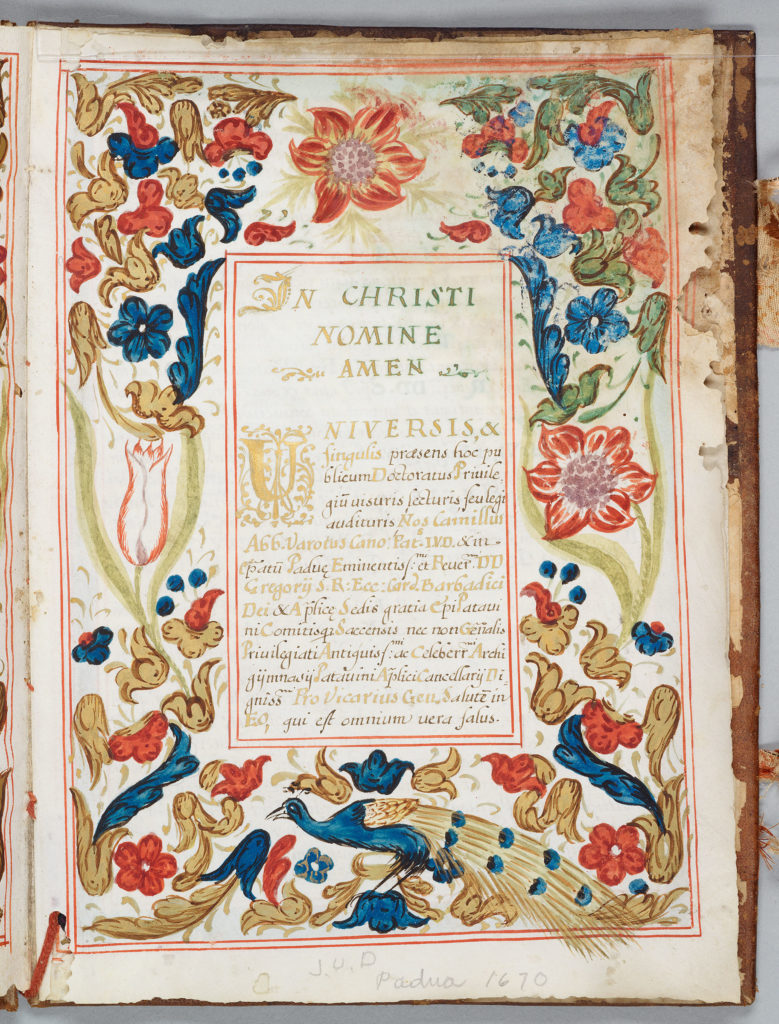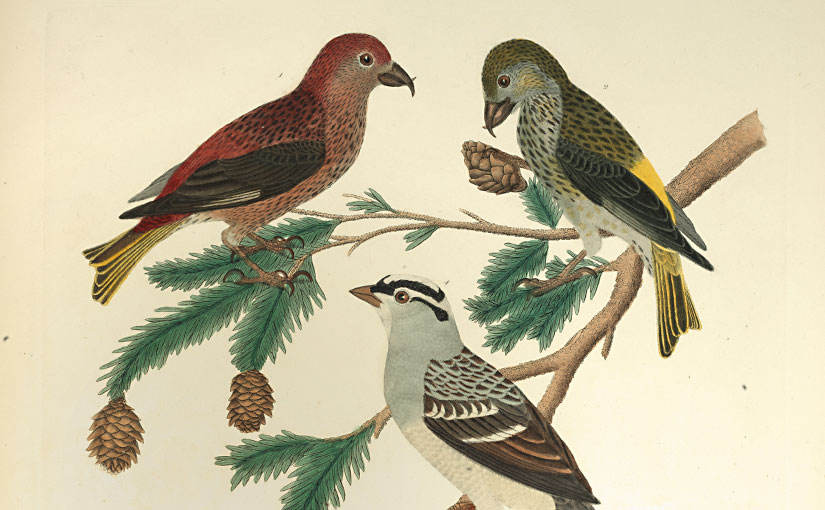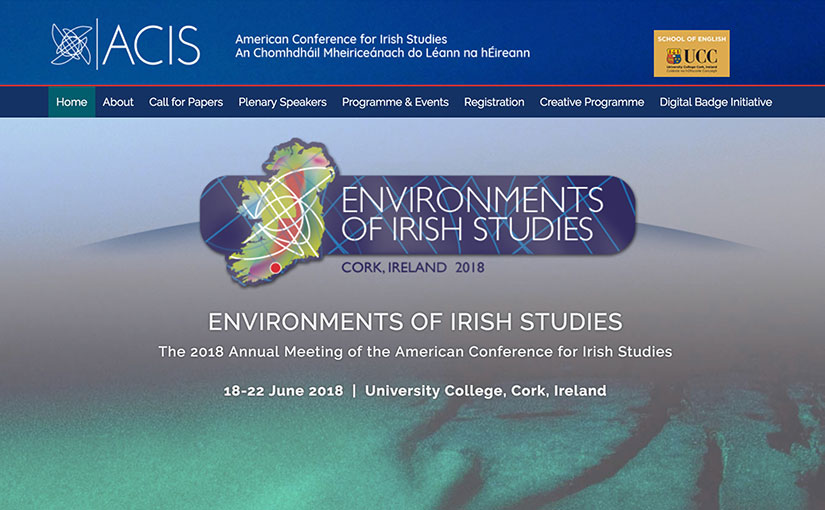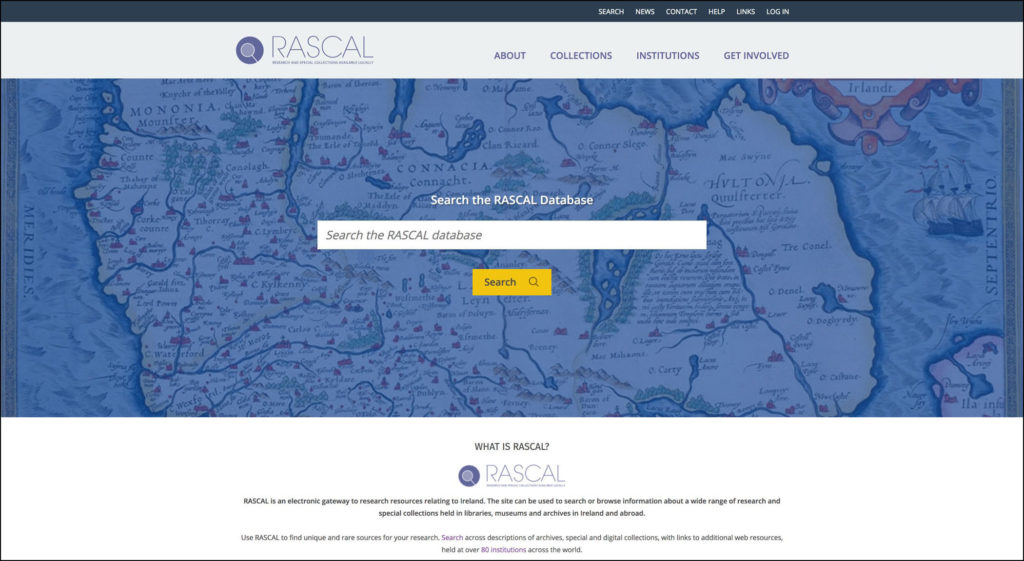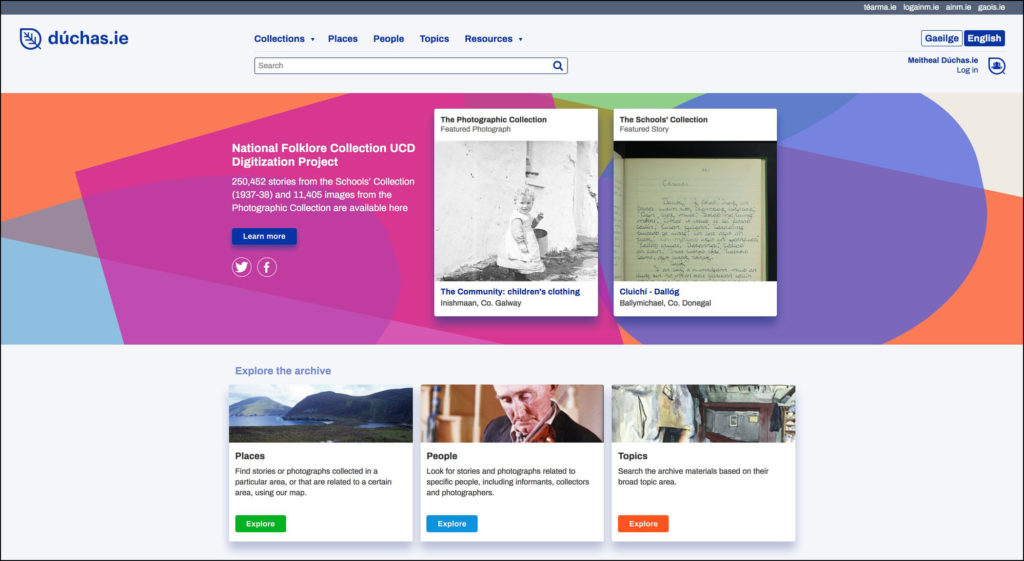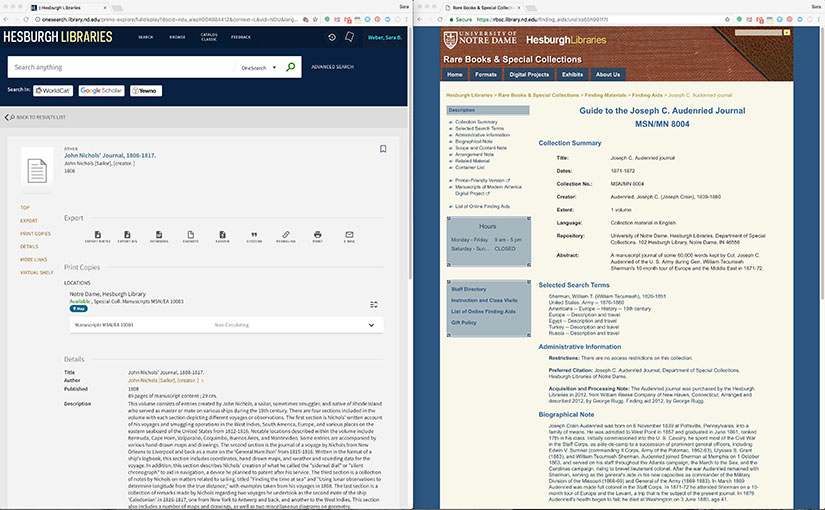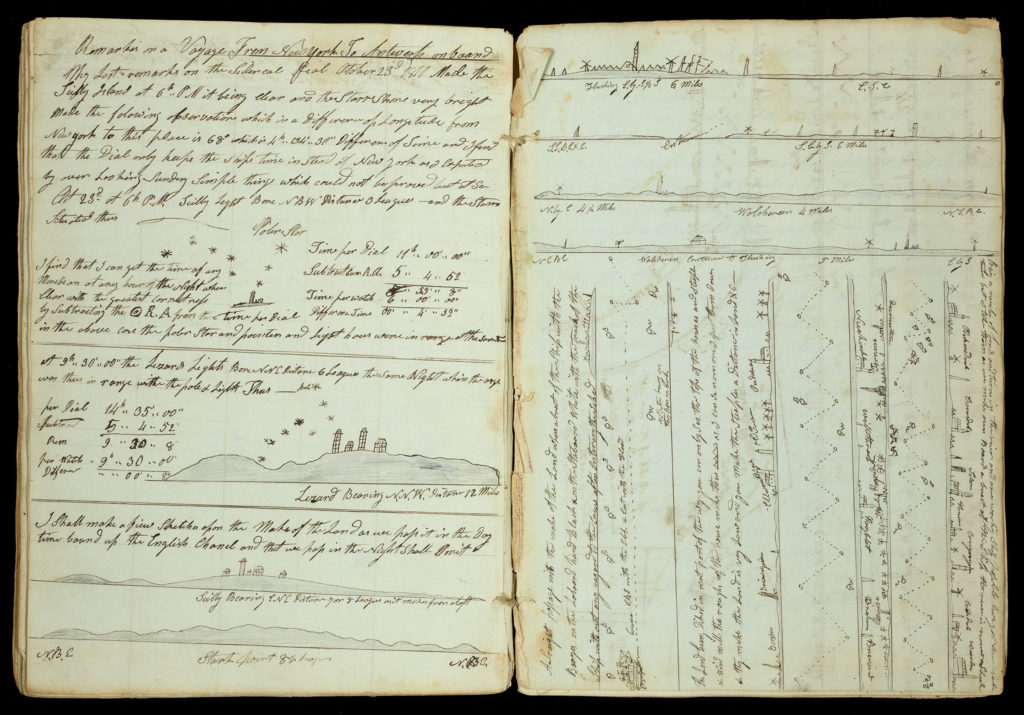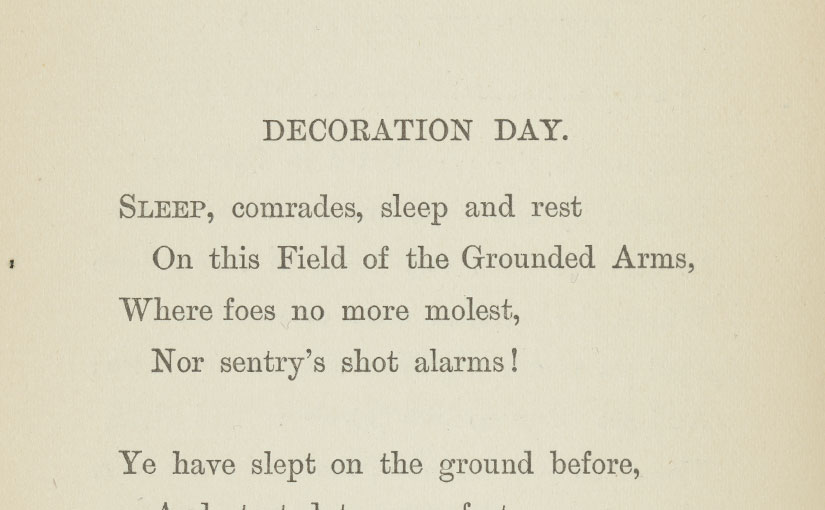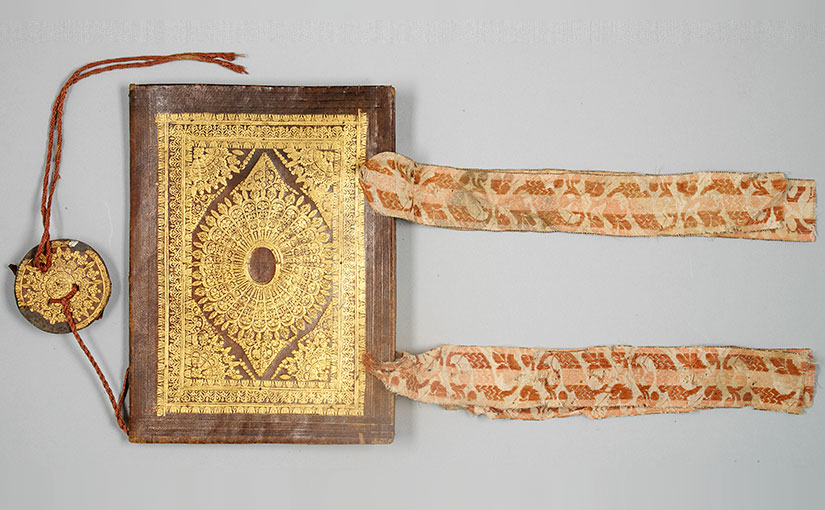Rare Books and Special Collections is open through Friday, December 21, 2018. We will be closed for the Christmas and New Year’s Break December 24, 2018, through January 1, 2019. We will reopen on Wednesday, January 2, 2019.
Tag: news
Upcoming Events: December and early January
There are no events scheduled to be hosted in Rare Books and Special Collections in December or early January 2019.
Rare Books and Special Collections will be closed for Notre Dame’s Christmas and New Year’s Break (December 24, 2018, through January 1, 2019).
We otherwise remain open for our regular hours during Reading Days and Exams, and welcome those looking for a quiet place to study.
There are just two more weeks to see the exhibit In Solzhenitsyn’s Circle: the Writer and his Associates, which runs through December 14 (the Friday of Notre Dame’s final exams week).
The current spotlight exhibits are Frankenstein 200 (August – December 2018) and Delamarche’s États-Unis de l’Amérique septentrionale: The United States in 1785 (November – December 2018).
Upcoming Events: November and early December
Please join us for the following events being hosted in Rare Books and Special Collections:
Tuesday, November 6 at 3:00pm | Workshop: Alternate Careers in Rare Books, Special Collections, Archives, and Museums.
Wednesday, November 7 at 3:30pm | Black Catholic History Month: “The Black Catholic Movement: The First 50 Years, 1968–2018” by Fr. Clarence Williams, CPPS, Ph.D. Co-sponsored by the Cushwa Center for the Study of American Catholicism, Hesburgh Libraries, and the University Archives.
Thursday, November 8 at 5:00pm | The Italian Research Seminar: “Fascist Im/Mobilities: A Decade of Amedeo Nazzari” by Alberto Zambenedetti (Toronto). Sponsored by Italian Studies at Notre Dame.
Friday, November 9 at 3:00pm | Operation Frankenstein: “Melodramatic Frankenstein: Radical Content in a Reactionary Form” by Jeff Cox (University of Colorado Boulder). Co-sponsored by the Department of English and the Indiana Humanities Council.
Tuesday, November 13 at 3:00pm | Workshop: Archival Skills. CANCELED
Thursday, November 15 at 4:30pm | Iberian & Latin American Studies: “Language and Power: Searching for the Origins of Catalan Linguistic Identity” by Vicente Lledó-Guillem (Hofstra University). Co-sponsored by the Department of Romance Languages and Literatures, the Institute for Scholarship in the Liberal Arts, the Medieval Institute, the Nanovic Institute for European Studies, and the Center for the Study of Languages and Cultures.
Thursday, November 29 at 5:00pm | The Italian Research Seminar: “Dante’s Florentine Intellectual Formation: From Quodlibets to the Vita nuova” by Lorenzo Dell’Oso (Ph.D. Candidate, Notre Dame). Sponsored by Italian Studies at Notre Dame.
The exhibit In Solzhenitsyn’s Circle: the Writer and his Associates runs through the end of the semester.
The current spotlight exhibits are Frankenstein 200 (August – December 2018) and Delamarche’s États-Unis de l’Amérique septentrionale: The United States in 1785 (November – December 2018).
RBSC will be closed during Notre Dame’s
Thanksgiving Break (November 22-25, 2018).
Upcoming Events: October and early November
Please join us for the following events being hosted in Rare Books and Special Collections:
Friday, October 12 at 3:00pm | Frankenstein and Medical Ethics: A Panel with Faculty from Notre Dame and Indiana University School of Medicine-South Bend (IUSM-SB).
• Mark Fox, MD PhD MPH (IUSM-SB), Modern Day Re-animation: Revisiting the Moral History of Transplantation
• Joseph Kotva, PhD (IUSM-SB), Frankenstein and an Ethics of Virtue
• Gary Fromm, MD (IUSM-SB), Frankenstein, Film, and Medical Education
• Kathleen Eggleson, PhD (IUSM-SB), Teaching Frankenstein Today: The Moral Imperative to Reform the Education of Medical Scientists
• Chair, Eileen Hunt Botting, Professor of Political Science (Notre Dame)
This event is part of Operation Frankenstein, a semester-long series of interdisciplinary events taking place at the University of Notre Dame to celebrate the bicentennial of Mary Shelley’s novel.
Tuesday, October 23 at 4:00pm | Public Lecture: “La primera entrada al Río de la Plata: Maldonado y su historia” / “The First Entry to the Rio de la Plata: Maldonado and Its History” by Silvia Guerra (Uruguayan poet and scholar).
Wednesday, October 24 at 4:00pm |Un mar en madrugada / A Sea at Dawn: Bilingual Reading by Silvia Guerra and Jesse Lee Kercheval.
Thursday, October 25 at 5:00pm | Italian Lecture: “Primo Levi e Dante: quattro casi (più o meno noti)” / “Primo Levi & Dante: Four Cases (More or Less Known)” by Fabrizio Franceschini (Pisa). Sponsored by Italian Studies at Notre Dame.
Wednesday, November 7 at 3:30pm | Black Catholic History Month public lecture by Fr. Clarence Williams, CPPS, Ph.D. Co-sponsored by the Cushwa Center for the Study of American Catholicism and Hesburgh Libraries/University Archives
Thursday, November 8 at 5:00pm | The Italian Research Seminar: “Fascist Im/Mobilities: A Decade of Amedeo Nazzari” by Alberto Zambenedetti (Toronto). Sponsored by Italian Studies at Notre Dame.
The exhibit In Solzhenitsyn’s Circle: the Writer and his Associates runs through the end of the semester. The exhibit will be open special hours during the Notre Dame Center for Ethics and Culture’s 19th Annual Fall Conference “Higher Powers” (November 1–3, 2018).
The current spotlight exhibits are Frankenstein 200 (August – December 2018) and A Modern Prometheus: Balancing Science and Ethics (September – October 2018).
RBSC is open regular hours during Notre Dame’s
Fall Break (October 15-19, 2018).
Upcoming Events: September and early October
Please join us for the following events being hosted in Rare Books and Special Collections:
Friday, September 7 at 1:00pm | Operation Frankenstein: “Illustrated Frankenstein: The 200th Anniversary Edition” by David Plunkert (artist and illustrator). Operation Frankenstein is a semester-long series of interdisciplinary events taking place at the University of Notre Dame to celebrate the bicentennial of Mary Shelley’s novel.
Thursday, September 20 at 5:00pm | The Italian Research Seminar: “The Face of Recent Italian Criminal Television: Gomorrah and Beyond” by Dana Renga (Ohio State). Sponsored by Italian Studies at Notre Dame.
The exhibit In Solzhenitsyn’s Circle: the Writer and his Associates runs through the end of the semester.
The current spotlight exhibits are Frankenstein 200 (August – December 2018) and A Modern Prometheus: Balancing Science and Ethics (September – October 2018).
RBSC is closed Monday, September 3rd, for Labor Day.
Upcoming Events: August and early September
Please join us for the following events being hosted in Rare Books and Special Collections:
Wednesday, August 22 at 3:00pm | “The Conservation of Dante’s 1477 La Commedia.” A public talk by Jeff Peachey (Independent Book Conservator, New York City). The conservation treatment of the Hesburgh Libraries’ important copy of Dante’s La Commedia (Venice: Vindelinus de Spira, 1477) will be detailed in this profusely illustrated lecture. Bibliophiles, conservators, librarians, Italian scholars, and anyone curious about the physical structure of books will find this lecture of interest.
Thursday, August 23 at 5:00pm | The Italian Research Seminar: “The Scene of the Crime: Tombolo On- and Off-Screen” by Charles Leavitt (Notre Dame). Sponsored by Italian Studies at Notre Dame.
Friday, September 7 at 1:00pm | Operation Frankenstein: “Illustrated Frankenstein: The 200th Anniversary Edition” by David Plunkert (artist and illustrator for The New Yorker). Operation Frankenstein is a semester-long series of interdisciplinary events taking place at the University of Notre Dame to celebrate the bicentennial of Mary Shelley’s novel.
The exhibit In Solzhenitsyn’s Circle: the Writer and his Associates will open on August 20 and run through the end of the semester.
The current spotlight exhibits are Frankenstein 200 (August – December 2018) and The Forbes Simulachres: The “Dance of Death” Reimagined (July – August 2018).
RBSC will be closed Monday, September 3rd, for Labor Day.
Librarians at the American Conference for Irish Studies
by Aedín Ní Bhróithe Clements, Irish Studies Librarian
This year’s American Conference for Irish Studies, or ACIS 2018, was held in the beautiful campus of University College Cork (UCC), in the south of Ireland. The biggest annual conference on Irish studies, it includes many disciplines, and over one hundred panels were convened during the five days in addition to plenary lectures, book launches and, importantly, regular breaks where colleagues could meet and discuss common interests.
An ‘ad hoc group’ of librarians and archivists has been active in ACIS for some years now, carving out a niche within the conference to come together and learn from one another. Presentations at the five library and archives events were stimulating, informative and well attended, and participants have returned to their libraries inspired and invigorated.
We learned about specific collections and books, and about exciting and innovative projects. We share a mission to collect and preserve our collections, and we also strive to make our collections visible and accessible. In fact, the Hesburgh Libraries’ mission, to connect people to knowledge across time and space, implies the collection and preservation of that knowledge and emphasizes the connecting element, which was a recurrent theme in this conference.
As the conference was in Ireland, American librarians and scholars had an opportunity to learn about exciting projects at the National Library of Ireland, Queen’s University Belfast, Dúchas and the National Folklore Collection, and the Irish Traditional Music Archive. We also learned from one another of interesting collections, both historic and newly-developed, and of interesting ways to make specific collections available digitally. An unexpected pleasure was a special visit offered by the Boole Library at UCC.
Some of the highlights are mentioned here, with links for further exploration.
Sharing and Making Collections and Data Accessible
RASCAL is a database of descriptions of collections relevant for the study of Ireland, held at libraries, archives and museums. Louisa Costello of Queens University Belfast described this project and the latest developments which include both a new-look website and an improved data entry form that will make it easier for librarians to submit information on collections. Currently, only one of Notre Dame’s Irish collections, the O’Neill Collection, has been entered in the RASCAL database, and so news of the new data submission form was very encouraging, and we expect that the database will be much improved in coming months by data entered by librarians at U.S. institutions.
Immediate examples of RASCAL’s utility could be seen throughout the conference. Ciara Ryan, pursuing her Ph.D. at UCC, has been working with a fascinating manuscript collection of an Irish-speaker and storyteller who worked as a miner in Montana. She demonstrated some of this collection from the Butte-Silver Bow Archives at the Digital Projects Showcase. The RASCAL database could provide a way for researchers to learn of this unexpected collection in a Montana archives.
Other collections were described during the conference and as RASCAL was explained, we were all considering how these could be included in the RASCAL database for increased visibility. These include the various collections at the Ward Irish Music Archives in Milwaukee, the collections at ITMA, the Dion Boucicault Collection which is being digitized at the University of South Florida and the P. S. O’Hegarty Collection at the University of Kansas. Researchers might consider searching the Irish Traditional Music Archive to find sources on Irish music and related culture, but it is unlikely that a scholar would stumble on the rich collection of P.S. O’Hegarty in Kansas without some guidance.
Discussion of Collections
The conference provided a forum for many descriptions of collections and even of single items. These were attended both by librarians, who are generally interested in all collections, and by scholars who wished to learn more about specific collections. Presentations on collections discussed issues of organization and digitization in ways that made the discussion accessible and relevant to scholars, librarians and archivists alike.
In all, three speakers addressed the National Folklore Collection at University College Dublin, and Fiontar, the digital humanities and Irish language group at Dublin City University that has developed websites on placenames, terminology and biography, and also the digitized folklore collection, Dúchas, or duchas.ie.
The National Folklore Collection, is recognized by UNESCO for its “outstanding universal value to culture”. Fiontar initially digitized the Schools Folklore Collection, and more recently the Photographic Collection has been added.
The Schools Folklore Collection was carried out in 1937-39 by the Irish Folklore Commission, the Department of Education and the Irish National Teachers’ Organization. Children in primary schools all over the 26 counties of the Irish Free State were asked to collect folklore, often interviewing their parents, grandparents or neighbors.
A remarkable collection was amassed in this way, hundreds of thousands of pages, from more than fifty thousand school pupils. This has now been digitized on Duchas.ie, and the riches of the collection are already apparent. The collection can now be searched by place, name and topic, and the revision of the classification system to enable better searching in the digital collection made for a fascinating talk by Jonny Dillon.
To enable full-text searching, for which the handwritten pages need to be transcribed, Dúchas.ie initiated a Meitheal, the Irish equivalent of the American barn raising or gathering of neighbors to share in the work. Volunteers of the Meitheal have transcribed many of the pages, and at this point, 24% of the 95,511 Irish language pages are transcribed, and 31% of the 348,812 English language pages are completed.
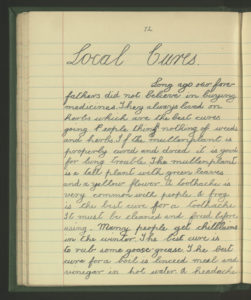
The page shown here is exemplary of one of the very understandable demands made of this collection: “Can I see the pages contributed by my family members?” This page on folk cures, including the use of fried frogs for toothache, is by Richard Forrestal of Convent View, Tullamore. Richard, my father’s cousin, is now in his nineties and living in Long Island, New York. Thanks to the initial data entry of names, places and titles, such pages can easily be found in the database. And some of this data entry was carried out by student interns from Notre Dame.
In contrast to the large collections of the National Folklore Collection, an engaging presentation by Crónán Ó Doibhlin of UCC’s Boole Library described one book, Leabhar Mór na hÉireann, The Great Book of Ireland, a spectacular artistic creation composed of art and manuscript poems and music by Ireland’s leading artists, poets and composers. Another single-book discussion was the round table discussion devoted to the production of The Atlas of the Irish Revolution, in which the tools of digital humanities were used to great effect.
In addition to traditional panel presentations, this conference offered a Digital Projects Showcase in which presenters demonstrated their projects as attendees moved around the showcase area. This new “showcase” format, organized by Kathleen Williams of Boston College, worked very well and we hope to replicate and develop it at future conferences. It allowed those interested mainly in music, for example, to stop at the tables of Beth Sweeney who demonstrated Boston College’s digitized collection of musician Séamus Connolly, and Jeff Ksiazek, archivist at the Ward Irish Music Archives.
The Boston Pilot has been used by Boston College to extract data from many of its advertisements asking for information on Irish immigrants. These advertisements, common in the nineteenth century, frequently provided information on the sought-for person’s native county and the date and place of their arrival in America. Kathleen Williams of Boston College discussed the migration of the data from the original newspaper ads to eight printed volumes (Ruth-Ann Mellish Harris and Donald M. Jacobs, The Search for Missing Friends: Irish Immigrant Advertisements Placed in the Boston Pilot. Boston: New England Historic Genealogical Society, 1989), to an online database, and finally, to a dataset in Dataverse. Segments of the Pilot and Boston Pilot have been digitized by Boston College. An article titled “The Boston Pilot in the 1840’s” is available online from Boston College Libraries.
Using digital technology to improve access to documents that are already available online, ‘born digital’ was described by Emilie Pine in an account of a database created to make a lengthy and dense report accessible and meaningful for readers and researchers. Industrial Memories offers a way to search and analyze the Report of the Commission to Inquire into Child Abuse (2009), known as the Ryan Report. The Ryan Report is a hefty five-volume document detailing the investigation into abuse of children in institutions in the Irish Republic from 1936 on. The Industrial Memories Project makes it possible to search the report and the project has also used digital tools to interrogate the report to find hidden patterns in the text. These are demonstrated on the Industrial Memories website.
A digitization project that is in process, described to us by Deirdre Wildy of Queens University Belfast, is the important Field Day Anthology of Irish Writing. This is exciting news for all in Irish studies, and it appears that the “women’s anthology”, or volumes 4 and 5 will be available from JSTOR before too long.
New Formats – New Collections
Joanna Finegan described the National Library of Ireland’s selective web archiving, and her data on the speed at which political web content disappears following an election made people sit up and realize the importance of the NLI’s project. Our collections here at Notre Dame include many political pamphlets printed around the time of the 1798 Rising; we have a good collection of Northern Ireland pamphlets and ephemera that helps students understand the political messages and propaganda of the time. But for recent referenda and elections, archived web pages will be invaluable for future historians.
From the National Library also, Elizabeth Kirwan described the development of the Irish Queer Archive, the most comprehensive collection of material in Ireland relating to homosexuality, LGBT literature and general Queer studies.
The presentation of Grace Toland, Director of the Irish Traditional Music Archive, also addressed the original formats of materials, and ways to both preserve and make accessible, recorded music performances. ITMA is exemplary of the new model of archive where sharing the archival resources is a major priority, and ITMA is also working to develop new and better ways to use digital methods to represent its collection.
The ACIS Conference
There was much information gathered at the conference that we would love to share more broadly. For anyone interested in learning more, a list of the libraries and archives panels mentioned above is appended below, followed by a list of links to the various collections and projects mentioned.
Libraries, Archives and Digital Projects at ACIS 2018
The Environments of Libraries and Archives in Irish Studies 1: Issues in DigitiSation
Monday 18 June, 4 p.m.
Chair: Aedín Clements
Joanna Finnegan, The National Library of Ireland’s Web Archive: Resources for the Study of Ireland Online
Anna Bale and Conchúr Mag Eacháin, The Dúchas Project and the Digitization of the National Folklore Collection
Grace Toland, The Irish Traditional Music Archive
Matthew Knight and Elizabeth Ricketts, Shifting Environments in the Archives: Creating an Online Dion Boucicault Collection at the University of South Florida
Libraries and Archives
Tuesday 19 June, 2 p.m.
Chair: Christian Dupont
Conor Carville, Poetry, Crisis and the Arts Institution in Northern Ireland 1971-1972
Emilie Pine, Swipe Right: Gender, Commemoration, the Decade of Centenaries, and the Politics of Digital Spaces
Elspeth Healey, Collecting Ireland: Politics, Literature, and Bibliography in the Library of P. S. O’Hegarty
The Environments of Libraries and Archives in Irish Studies 2: Special Collections and Archives in the New Environment
Tuesday 19 June, 4 p.m.
Chair: Aedín Clements
Crónán Ó Doibhlin, The Great Book of Ireland – Leabhar Mór na hÉireann
Christian Dupont, The Environments of Libraries and Archives in Irish Studies
Deirdre Wildy and Louisa Costello, Special Collections at Queens University Belfast
Jonny Dillon, Preserving Tradition into the Future: The National Folklore Collection in a Transitional Phase
Twentieth-Century Irish Literary Archives
Wednesday 20 June, 9 a.m.
Chair: Paige Reynolds
Round Table participants: Ken Bergin, Elizabeth Kirwan, Aedín Clements, Adam Hanna, Florence Impens, and Ruud van den Beuken
Digital Projects Showcase
Wednesday 20 June, 2 p.m.
Organized by: Kathleen Williams (Boston College)
John Waters (New York University), Spatializing Subscription Lists and Topographical Poems
Jeff Ksiazek (WIMA), The Ward Irish Music Archives
Ciara Ryan (UCC), The Family Papers of Seán “Irish” O’Sullivan, Butte-Silver Bow (BSB) Archives, Butte, Montana
Kathleen Williams (Boston College), Information Wanted: A Database of Advertisements for Irish Immigrants in the Boston Pilot Newspaper: A New Version of the Data, Available on the Boston College Dataverse Site
Elizabeth Sweeney (Boston College), The Séamus Connolly Collection of Irish Music
Links to further information
ACIS:
https://acisweb.org/
ACIS 2018 (conference website):
http://acis2018.com/
Atlas of the Irish Revolution:
http://www.corkuniversitypress.com/Atlas-of-the-Irish-Revolution-p/9781782051176.htm
Dion Boucicault Collection:
http://www.lib.usf.edu/boucicault/
The Séamus Connolly Collection of Irish Music:
https://connollymusiccollection.bc.edu/
Duchas.ie:
https://www.duchas.ie/en
The Great Book of Ireland – Leabhar Mór na hÉireann:
https://cora.ucc.ie/handle/10468/3053?show=full
Industrial Memories:
https://industrialmemories.ucd.ie/
Information Wanted: A Database of Advertisements for Irish Immigrants Published in the Boston Pilot:
https://infowanted.bc.edu/
Dataset extracted from the Information Wanted online database:
https://dataverse.harvard.edu/dataset.xhtml?persistentId=doi:10.7910/DVN/UNJU3N
ITMA (Irish Traditional Music Archive):
https://www.itma.ie/
P. S. O’Hegarty Collection at Kansas University:
https://spencer.lib.ku.edu/collections/special-collections/irish
Irish Queer Archive:
http://www.nli.ie/pdfs/mss%20lists/151_IQA.pdf
NLI Web Archive Collections:
https://www.nli.ie/en/udlist/web-archive-collections.aspx
RASCAL:
http://www.rascal.ac.uk/index.php/
Ward Irish Music Archives:
https://wardirishmusicarchives.com/Ward-Music-Archives.htm
Developments in Description and Discoverability
by Patrick Milhoan, Lead Processing Archivist
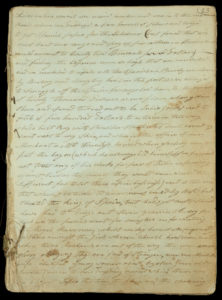
Notre Dame’s Rare Books and Special Collections boasts some truly remarkable collections with items covering a multitude of topics. From collections totaling 17 cubic feet, such as the Vagrich and Irene Bakhchanyan Collections, to single-item manuscripts totaling a few pages, such as the John Nichols Journal, the collections are not only diverse in content, but also in size. Just as the collections at Notre Dame are diverse, so too are the descriptive tools used to make them discoverable
Descriptive or discovery tools used in special collections and archives come, traditionally, in two forms—the archival finding aid and a MARC record. However, not all collections items fit within the scope of use for these two tools. Finding aids are useful for large collections that require much more in-depth description than a current MARC record allows for when considering the hierarchical nature of collections. In the case of collections with only a few items, the collection does not need in-depth description and does not utilize the descriptive power that a finding aid provides. The traditional MARC record, however, is inadequate because the conventions for bibliographic description do not accommodate enough of the information required to describe an archival collection.
Recognizing that the current tools were insufficient, members of the Society of American Archivists (SAA) and the Rare Book and Manuscript Section (RBMS) of the American Library Association (ALA) set out to create a new descriptive standard that would combine archival descriptive standards within existing bibliographic frameworks. These efforts culminated in the publication of a new bibliographic standard in 2016 for single-item manuscripts called DCRM (MSS)—Descriptive Cataloging of Rare Materials (Manuscripts).
As previously mentioned, Rare Books and Special Collections holdings consist of materials both large and small. In fact, a majority of the collections consist of very few pages, often just a single item. In the past, these items were made discoverable by listing the items in a register on the department’s website. With the advent of the new descriptive standard, we are able to create catalog records that describe both the artifactual information and the contextual information of small collections, especially ones with single items, that traditional MARC records did not allow for. We have decided to create a few test records for our collections using this new standard.
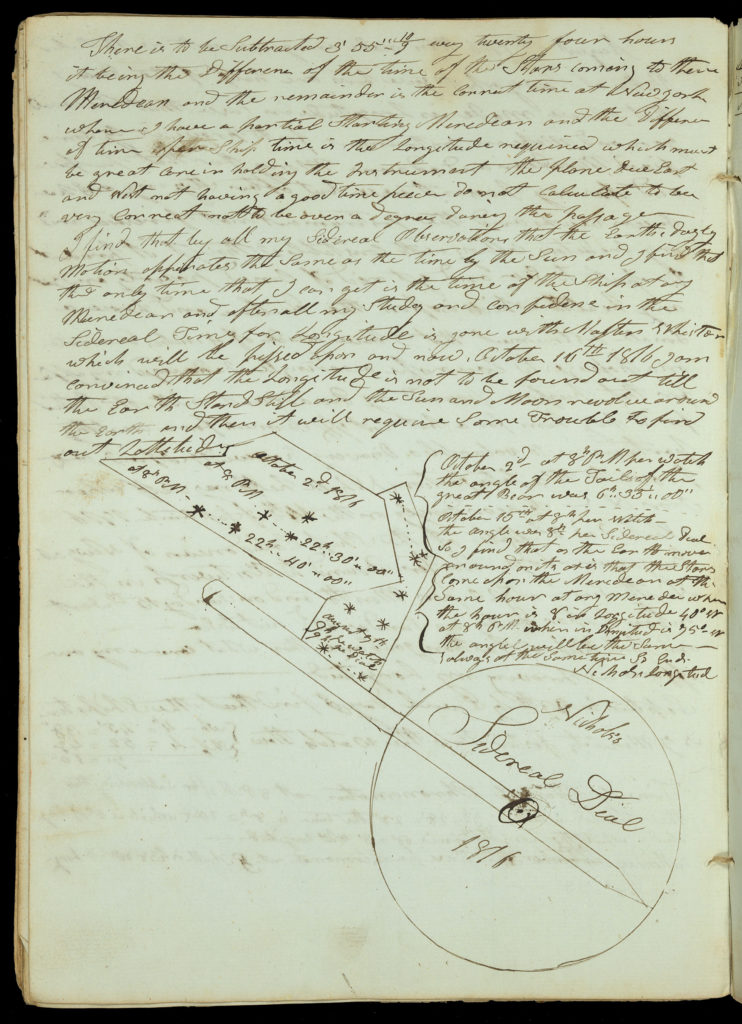 One of the first items we decided to describe using DCRM (MSS) was the John Nichols Journal (MSN/EA 10003). Nichols, born in Rhode Island, was a 19th-century sailor and smuggler who wrote about his exploits in a 4-section journal. In the journal, Nichols describes his voyages to the West Indies, including smuggling operations in Cuba and Brazil. In addition, Nichols also describes an invention he has termed the “sidereal dial” for navigation at night. Accompanying the entries are numerous hand-drawn maps and profiles of locations Nichols encountered throughout his journeys on the General Hamilton and the Caledonian.
One of the first items we decided to describe using DCRM (MSS) was the John Nichols Journal (MSN/EA 10003). Nichols, born in Rhode Island, was a 19th-century sailor and smuggler who wrote about his exploits in a 4-section journal. In the journal, Nichols describes his voyages to the West Indies, including smuggling operations in Cuba and Brazil. In addition, Nichols also describes an invention he has termed the “sidereal dial” for navigation at night. Accompanying the entries are numerous hand-drawn maps and profiles of locations Nichols encountered throughout his journeys on the General Hamilton and the Caledonian.
Using DCRM (MSS) as our descriptive standard allows for a greater level of discoverability for our collections items. Not only are our collections browsable on our website, but they are now searchable through the Hesburgh Libraries catalog as well as the Online Computer Library Center online catalog (OCLC WorldCat)—the world’s largest online public access catalog—and ArchiveGrid—an online database containing over 5 million records for archival materials located in repositories in the US and internationally. In addition, DCRM (MSS) has been an effective way to systematically reduce our processing backlog and refine our procedures in accordance with newly adopted best practices and standards of the profession.
Memorial Day 2018
To honor all who died while serving in the United States Armed Forces.
Originally, Memorial Day was celebrated as Decoration Day.
“Decoration Day,” by Henry Wadsworth Longfellow, was published posthumously—first in June 1882 in The Atlantic and later that same year in In the Harbor, a book containing previously unpublished poems. The poem “pays tribute to what was then a new form of civic observance: a day set aside to commemorate those who had perished in the Civil War by placing flags and flowers on soldiers’ graves, a custom that gradually gave rise to our modern Memorial Day honoring all who give their lives in military service.” (David Barber, The Atlantic, May 30, 2011)
Henry Wadsworth Longfellow (1807-82) was but five years old when he witnessed the War of 1812 devastate his hometown. This event had a long-lasting impact on him.
Wordsworth would go on to Bowdoin College, graduating along with Nathaniel Hawthorne in 1825 before traveling through Europe, where he gained mastery over seven languages. On his return to the US, he taught languages first at Bowdoin and later at Harvard, and also spent much time writing textbooks and essays on languages, particularly French, Italian, and Spanish. While at Harvard, Longfellow’s literary career took off. He travelled to Europe twice more before resigning from Harvard in 1854 to devote his full attention to writing.
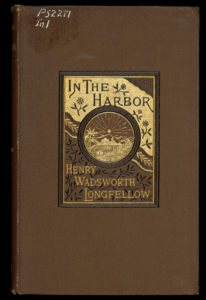 Less than a decade later—in 1861—not only did his beloved wife, Fanny, die but the Civil War broke out and his son, fighting for the Union, was wounded. The invalid had to be escorted home by his father and brother. To cope with these tragedies, Longfellow immersed himself in his literary endeavors including a full translation of Dante’s Divine Comedy (completed in 1864). Against memories of the War of 1812, the Civil War, and the traumatic loss of a wife and the injury of a son, Longfellow continued to write. In some of his last pieces, including “Decoration Day,” one cannot help but notice Longfellow’s solemnity and poignancy.
Less than a decade later—in 1861—not only did his beloved wife, Fanny, die but the Civil War broke out and his son, fighting for the Union, was wounded. The invalid had to be escorted home by his father and brother. To cope with these tragedies, Longfellow immersed himself in his literary endeavors including a full translation of Dante’s Divine Comedy (completed in 1864). Against memories of the War of 1812, the Civil War, and the traumatic loss of a wife and the injury of a son, Longfellow continued to write. In some of his last pieces, including “Decoration Day,” one cannot help but notice Longfellow’s solemnity and poignancy.
During June and July the blog will shift to a summer posting schedule, with posts every other Monday rather than every week. We will resume weekly publication on August 13th.
Congratulations to the 2018 Graduates!
All of us in Rare Books and Special Collections send our best wishes to all the 2018 graduates of the University of Notre Dame.
We would also like to congratulate:
Laura Neis (ND ’18), who received an honorable mention in the Senior and Honors Thesis category of the Undergraduate Library Research Awards (ULRA) for her senior thesis, “Rare Women and True Martyrs: Female Martyrdom under Queen Elizabeth I.” Laura conducted background research for her thesis using resources from the Rare Books collection.
Ed Kreienberg (ND ’18), who along with Camila Sacher (ND ’19) received the Monsignor Francis A. O’Brien Award for the best essay by a history major. Ed conducted research for his essay using the Le Rossignol Correspondence Collection, the Dr. George Marshall Oakden Collection, and the Humphrey M. Barbour World War I Scrapbooks.
Mia Alyse Mologousis (ND ’18), who won the Joseph Italo Bosco Award for Excellence in Italian Studies. Mia’s research materials included the La Difesa Della Razza periodical in Special Collections Italian literature holdings.
